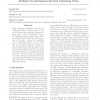Free Online Productivity Tools
i2Speak
i2Symbol
i2OCR
iTex2Img
iWeb2Print
iWeb2Shot
i2Type
iPdf2Split
iPdf2Merge
i2Bopomofo
i2Arabic
i2Style
i2Image
i2PDF
iLatex2Rtf
Sci2ools
115
click to vote
ICML
2010
IEEE
2010
IEEE
Multiple Non-Redundant Spectral Clustering Views
Many clustering algorithms only find one clustering solution. However, data can often be grouped and interpreted in many different ways. This is particularly true in the high-dimensional setting where different subspaces reveal different possible groupings of the data. Instead of committing to one clustering solution, here we introduce a novel method that can provide several non-redundant clustering solutions to the user. Our approach simultaneously learns non-redundant subspaces that provide multiple views and finds a clustering solution in each view. We achieve this by augmenting a spectral clustering objective function to incorporate dimensionality reduction and multiple views and to penalize for redundancy between the views.
| Added | 26 Jan 2011 |
| Updated | 26 Jan 2011 |
| Type | Journal |
| Year | 2010 |
| Where | ICML |
| Authors | Donglin Niu, Jennifer G. Dy, Michael I. Jordan |
Comments (0)

